You searched for: ust众筹理财项目定制开发【tg���������@ek7676】平台包网搭建unit众筹理财项目定制开发【tg���������@ek7676】平台包网搭建gnogu7gctt
<< Previous | Displaying results 251-300 of 1751 for "ust众筹理财项目定制开发【tg���������@ek7676】平台包网搭建unit众筹理财项目定制开发【tg���������@ek7676】平台包网搭建gnogu7gctt" | Next >>
-
Japanese American relocation
PhotoAmerican residents of Japanese ancestry wait with their luggage for transportation during relocation, San Francisco, California, April 6, 1942.
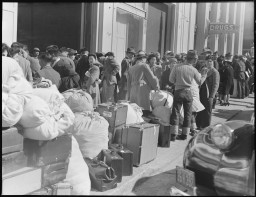
-
Eugenic and Health Exhibit Kansas Free Fair, 1929
PhotoThe American Eugenics Society displays an exhibit on health and eugenics at the Kansas Free Fair in 1929.

-
The Ku Klux Klan
PhotoThe Ku Klux Klan marches down Pennsylvania Ave in Washington, DC. Photograph by Harris & Ewing, 1926.
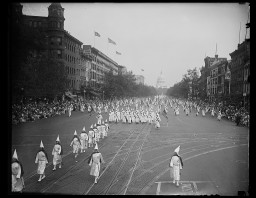
-
Opening of US Holocaust Memorial Museum
Timeline EventApril 22, 1993. On this date, dedication ceremonies for the United States Holocaust Memorial Museum take place.

-
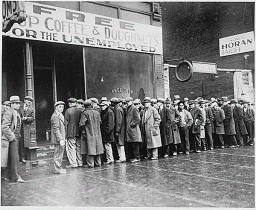
-
Roosevelt announces aid for Britain
FilmAlthough constrained by powerful isolationist sentiment in the United States, President Roosevelt was determined to help democratic Great Britain continue the war against Nazi Germany. Even as he promised to keep the United States neutral in the European war, Roosevelt ordered the expansion of military construction and pledged--as shown in this footage--that the United States would serve as the "great arsenal of democracy." In March 1941, Congress approved Lend-Lease aid for Britain. Britain ultimately…
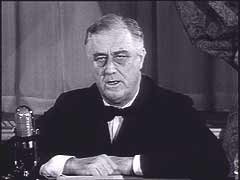
-
Liberation of Dachau
Media EssayDachau opened in March 1933 and was the first regular concentration camp to be established by the Nazi regime. The camp was liberated by American forces on April 29, 1945. As they approached the camp, troops encountered horrific evidence of Nazi a...
-
Washington Post article
ArtifactAn August 6, 1972, Washington Post article about former concentration camp guard Hermine Braunsteiner Ryan, entitled "From a Dark Past, A Ghost the U.S. Won't Allow to Rest".
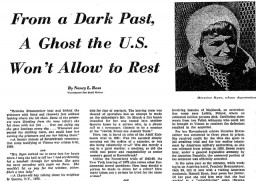
-
We Will Never Die, program cover, 1943
ArtifactThe program cover for "We Will Never Die" featured Arthur Szyk’s "Tears of Rage" artwork. The cover's original dimensions are: 12 1/16" x 9 1/16" x 3/16.

-
Gerhart Riegner
PhotoDr. Gerhart Riegner, World Jewish Congress representative in Geneva, Switzerland, sent a cable in August 1942 to American Jewish leader Stephen S. Wise about the Nazi plan to exterminate European Jewry. Date uncertain.
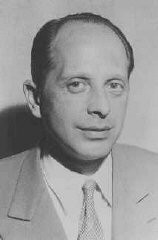
-
Insignia of the 2nd Infantry Division
PhotoInsignia of the 2nd Infantry Division. The nickname of the 2nd Infantry Division, "Indianhead," was derived from its World War I insignia. This insignia was developed from an emblem a truck driver in the division had painted on his truck.

-
Insignia of the 4th Infantry Division
PhotoInsignia of the 4th Infantry Division. The 4th Infantry Division's nickname, the "Ivy" division, is derived from the divisional insignia developed during World War I: four ivy leaves on a diamond field, symbolizing the roman numeral "IV."

-
Insignia of the 11th Armored Division
PhotoInsignia of the 11th Armored Division. "Thunderbolt" is a nickname adopted by the 11th Armored Division during its rapid march in December 1944 to reinforce US troops defending against the German military offensive in the Ardennes Forest.
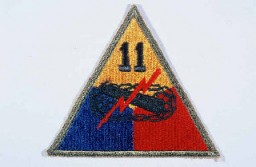
-
A survivor in Wöbbelin
PhotoA survivor in Wöbbelin. The soldier in the foreground of the photograph wears the insignia of the 8th Infantry Division. Along with the 82nd Airborne Division, on May 2, 1945, the 8th Infantry Division encountered the Wöbbelin camp. Germany, May 4-5, 1945.
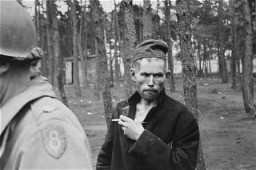
-
Insignia of the 20th Armored Division
PhotoInsignia of the 20th Armored Division. Although no nickname is commonly associated with the 20th, "Armoraiders" may have been occasionally in use during World War II.
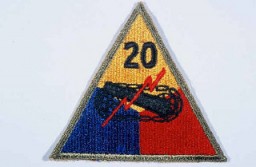
-
Insignia of the 104th Infantry Division
PhotoInsignia of the 104th Infantry Division. The nickname of the 104th Infantry Division, "Timberwolf," originated from the division's insignia, a gray timberwolf. The timberwolf, native to the Pacific Northwest, was chosen as representative of the area where the division was formed in 1942.
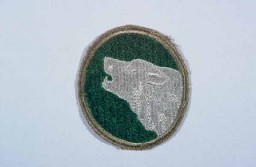
-
Insignia of the 3rd Armored Division
PhotoInsignia of the 3rd Armored Division. "Spearhead" was adopted as the nickname of the 3rd Armored Division in recognition of the division's role as the "spearhead" of many attacks during the liberation of France in 1944.

-
Myron Taylor at the Evian Conference
PhotoMyron Taylor, US delegate to the Evian Conference, pleads for the establishment of an intergovernmental committee to facilitate Jewish emigration. Evian-les-Bains, France, July 15, 1938.
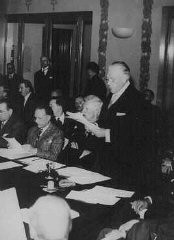
-
Insignia of the 65th Infantry Division
PhotoInsignia of the 65th Infantry Division. The 65th Infantry Division was nicknamed the "Battle Axe" after the divisional insignia, a halbert (an axe on a pole), used to cut through the enemy during medieval times.

-
Insignia of the 69th Infantry Division
PhotoInsignia of the 69th Infantry Division. The 69th Infantry Division gained the nickname the "Fighting 69th" during World War II. The name has no heraldic significance, but simply conveys the esprit de corps of the division.
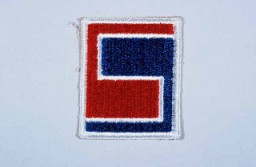
-
Insignia of the 71st Infantry Division
PhotoInsignia of the 71st Infantry Division. The nickname of the 71st Infantry Division, the "Red Circle" division, is based upon the divisional insignia (which includes a red circle).
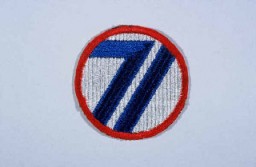
-
Insignia of the 12th Armored Division
PhotoInsignia of the 12th Armored Division. "Hellcats, " the winning entry in a division contest for a nickname held in early in 1943, symbolized the 12th's toughness and readiness for combat.
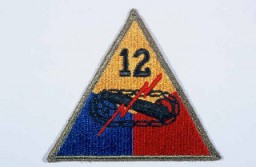
-
Depression Soup Kitchen
PhotoUnemployed men queued outside of a depression soup kitchen in Chicago.

-
Depression Breadlines in New York City
PhotoA long line of people waiting to be fed in New York City.

-
Martha Sharp
PhotoStudio portrait of Martha Sharp. Martha and Waitstill Sharp, American Unitarian aide workers, helped thousands of Jews, intellectuals, and children in Prague, Lisbon, and southern France in 1939–1940.

-
HIAS immigration certificate
PhotoHIAS immigration certificate issued to Manius Notowicz in Munich, Germany. The document states that Notowicz will travel on the Marine Flasher on February 22, 1947, to New York City.
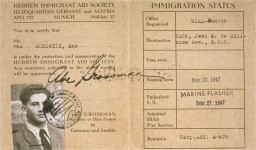
-
Army Military Police guard the Manzanar Relocation Center
PhotoArmy Military Police guarding the boundaries of the Manzanar Relocation Center in California, one of ten relocation camps where American residents of Japanese ancestry were forcibly deported, April 2, 1942.
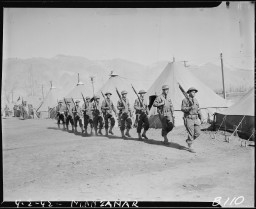
-
The 11th Armoured Division (Great Britain) - Photograph
Media EssayThe 11th Armoured Division liberated the Bergen-Belsen concentration camp in April 1945. When its soldiers entered the camp, they witnessed the horrific conditions that prisoners had faced.
-
The 11th Armoured Division (Great Britain) - ID Card/Oral History
Media EssayThe 11th Armoured Division liberated the Bergen-Belsen concentration camp in April 1945. When its soldiers entered the camp, they witnessed the horrific conditions that prisoners had faced. Here, survivors of Bergen-Belsen recount their experience...
-
Insignia of the 1st Infantry Division
PhotoInsignia of the 1st Infantry Division. The 1st Infantry Division's nickname, the "Big Red One," originated from the division's insignia, a large red number "1" on a khaki field. This nickname was adopted during World War I, when the 1st was the first American division to arrive in France.
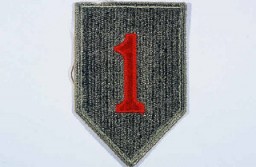
-
Insignia of the 4th Armored Division
PhotoInsignia of the 4th Armored Division. The commanding general of the 4th Armored Division refused to sanction an official nickname for the 4th, believing that the division's accomplishments on the battlefield made one unnecessary. "Breakthrough" was occasionally used, apparently to highlight the division's prominent role in the breakout from the Normandy beachhead and liberation of France in 1944.
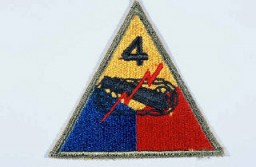
-
Insignia of the 14th Armored Division
PhotoInsignia of the 14th Armored Division. Although lacking a nickname during the war, the 14th became known as the "Liberators" soon afterward to signify its accomplishments in liberating hundreds of thousands of forced and slave laborers, concentration camp prisoners, and Allied prisoners of war in 1945.
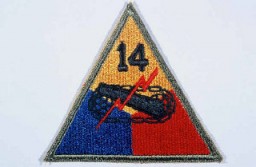
-
Insignia of the 84th Infantry Division
PhotoInsignia of the 84th Infantry Division. The 84th Infantry Division derives its nickname, "Railsplitter" division, from the divisional insignia, an ax splitting a rail. This design was created during World War I, when the division was known as the "Lincoln" division to represent the states that supplied soldiers for the division: Illinois, Indiana, and Kentucky. All figured prominently in the life of President Abraham Lincoln, of log-splitting legend.
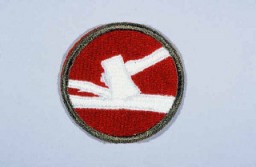
-
Insignia of the 86th Infantry Division
PhotoInsignia of the 86th Infantry Division. The 86th Infantry Division developed the blackhawk as its insignia during World War I, to honor the Native American warrior of that name who fought the US Army in Illinois and Wisconsin during the early nineteenth century. The nickname "The Blackhawks" or "Blackhawk" division is derived from the insignia.
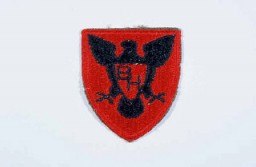
-
Insignia of the 83rd Infantry Division
PhotoInsignia of the 83rd Infantry Division. The 83rd Infantry Division received its nickname, the "Thunderbolt" division, after a division-wide contest for a new nickname held in early 1945. The earlier nickname, "Ohio," was based on the division's insignia (which includes the name "Ohio," where the division was raised during World War I). A new nickname was desired to represent the nationwide origins of the division's personnel during World War II.
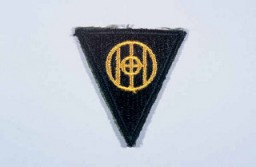
-
Insignia of the 9th Armored Division
PhotoInsignia of the 9th Armored Division. Although no nickname for the 9th was in common usage throughout World War II, "Phantom" division was sometimes used in 1945. It originated during the Battle of the Bulge, when the 9th Armored Division seemed, like a phantom, to be everywhere along the front.
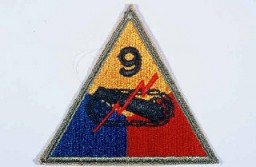
-
Insignia of the 95th Infantry Division
PhotoInsignia of the 95th Infantry Division. The 95th Infantry Division, the "Victory" division, gained its nickname from the divisional insignia approved in 1942: the arabic numeral "9" combined with the roman numeral "V" to represent "95." The "V" led to the nickname, since the letter "V" was universally recognized as an Allied symbol for resistance and victory over the Axis during World War II.
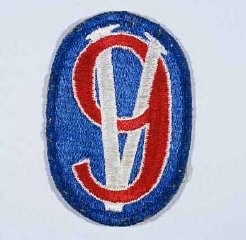
-
Insignia of the 8th Armored Division
PhotoInsignia of the 8th Armored Division. The nickname of the 8th Armored Division, the "Thundering Herd," was coined before the division went to Europe in late 1944. It was also known as the "Iron Snake" late in the war, after a correspondent for Newsweek likened the 8th to a "great ironclad snake" as it crossed the Rhine River in late March 1945.
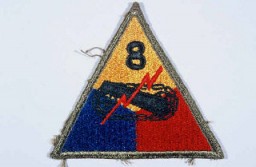
-
Insignia of the 8th Infantry Division
PhotoInsignia of the 8th Infantry Division. The 8th Infantry Division was known as both the "Golden Arrow" and "Pathfinder" division during World War II. Both nicknames originated from the division's insignia, which includes a gold arrow to represent the nineteenth century explorer of California, John Fremont. The division was formed in California in 1918.

-
Insignia of the 63rd Infantry Division
PhotoInsignia of the 63rd Infantry Division. The 63rd Infantry Division was nicknamed the "Blood and Fire" division soon after its formation in the spring of 1943. The nickname commemorates British prime minister Winston Churchill's statement at the Casablanca Conference in January 1943 that "the enemy would bleed and burn in expiation of their crimes against humanity." The divisional insignia illustrates the nickname.
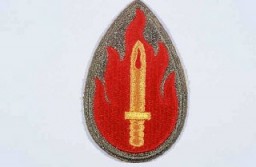
-
Scene during the Evian Conference on Jewish refugees
PhotoScene during the Evian Conference on Jewish refugees. On the far right are two of the US delegates: Myron Taylor and James McDonald of the President's Advisory Committee on Political Refugees. Evian-les-Bains, France, July 1938.
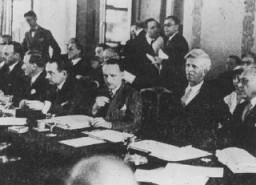
-
Insignia of the 45th Infantry Division
PhotoInsignia of the 45th Infantry Division. The 45th Infantry Division gained its nickname, "Thunderbird" division, from the gold thunderbird. This Native American symbol became the division's insignia in 1939. It replaced another previously used Native American symbol, a swastika, that was withdrawn when it became closely associated with the Nazi Party.
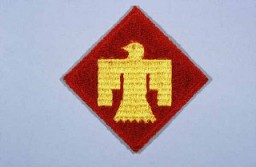
-
Insignia of the 42nd Infantry Division
PhotoInsignia of the 42nd Infantry Division. The nickname of the 42nd Infantry Division, the "Rainbow" division, reflects the composition of the division during World War I. The division was drawn from the National Guards of 26 states and the District of Columbia. It represented a cross section of the American people, as the rainbow represents a cross section of colors.

-
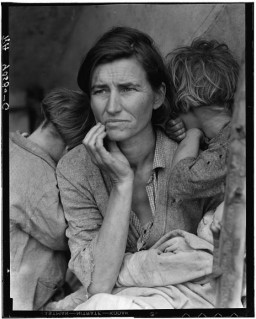
-
Vladka Meed with President Jimmy Carter
PhotoVladka Meed shakes the hand of President Jimmy Carter at a White House Rose Garden ceremony. The ceremony marked the official presentation of the report of the US Holocaust Commission to the president by commission chairman Elie Wiesel (second from right, with Benjamin Meed, center). Washington, DC, September 27, 1979.

-
Japanese Americans in line to register with the War Relocation Authority
PhotoJapanese Americans wait in line to register with the War Relocation Authority, San Francisco, California, April 1942. A government agency, the War Relocation Authority was tasked with removing “enemy aliens” from designated zones. Local authorities on the West Coast forced all “persons of Japanese ancestry” to register. They were then deported, first to temporary “assembly centers” and from there to relocation centers.

-
Nursery school children at the Heart Mountain Relocation Center
PhotoA group of nursery school children at the Heart Mountain Relocation Center in Wyoming, January 4, 1943. The Heart Mountain Relocation Center was one of ten relocation centers where Japanese Americans were forcibly deported.
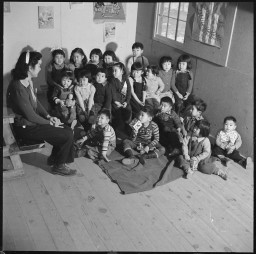
-
Liberation of Bergen-Belsen
Timeline EventApril 15, 1945. On this date, the British army liberated approximately 60,000 prisoners at the Bergen-Belsen concentration camp.

-
US Forces Liberate Buchenwald
Timeline EventApril 11, 1945. On this date, Buchenwald prisoners stormed the watchtower and seized control of the camp. US forces liberated the camp the same day.
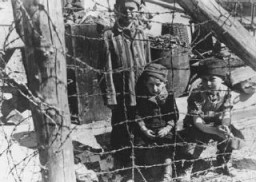
-
Insignia of the 89th Infantry Division
PhotoInsignia of the 89th Infantry Division. The 89th Infantry Division's nickname, the "Rolling W," is based on the division's insignia. Created during World War I, this insignia utilized a letter "M" inside a wheel. When the wheel turns, the "M" becomes a "W." The letters "MW" signify the mid-west origin of the troops who formed the 89th during World War I. The division was also known as the "Middle West" division, another variation on its origin.

